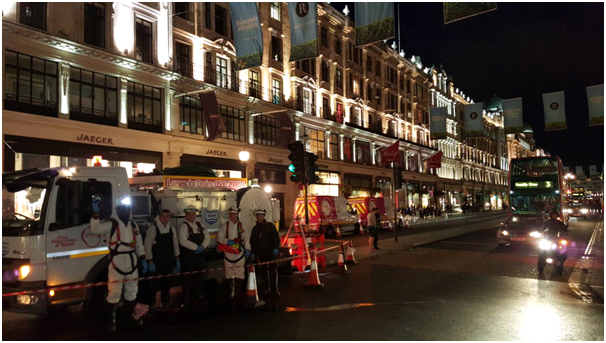Lanes Group tackles fatberg to keep the tills jingling in Regent Street

Lanes Utilities has removed a fatberg from a sewer beneath one of the globe’s world class shopping destinations to keep the tills rolling and the shoppers happy.
A number of major retailers along Regent Street in London’s West End had experienced drain problems, prompting Thames Water to send an emergency team from Lanes Utilities, part of Lanes Group, to investigate.
They found that a block of fat and other debris weighing more than a tonne had built up at a critical point in the sewer that runs along Regent Street.
This then caused waste water to back up into some connecting drains.
In a three-hour operation, the team removed the fatberg and cleared the sewer, allowing it to run freely again, which cured drainage problems experienced by the retail businesses above.
Field Manager Craig May, who led Lanes Utilities’ fatberg-busting team said: “This was a relatively small fatberg by the stands of some that we’ve discovered. But it was causing a nuisance, and had to be removed.
“It had built up at a weir in the sewer, where the Regent Street Sewer drops about 15 metres down to connect with a deep-level trunk sewer. The fatberg was about a metre wide, a metre high and about a metre long.
“We had to dig it out with shovels, and take the debris back to the manhole, where some of it could be vacuumed up to the surface using one of our jet vacuumation tankers. Larger lumps were lifted out in buckets.”
The team was under pressure to unblock the sewer as quickly as possible to minimise inconvenience for road users and shoppers.
To reach the sewer manhole, they had to close one lane of Regent Street at 7 o’clock on a Friday evening, one of the busiest late shopping days of the week.
As Thames Water’s sole wastewater maintenance contractor, Lanes Utilities is regularly tasked with tackling fatbergs where, in London, specimens have been found weighing more than 15 tonnes and more than 100 metres in length.
They are caused by a build-up of fats and oils, plus other debris, such as sanitary products and wipes, which are wrongly disposed of down sinks, drains and toilets.
Tackling the issue costs Thames Water over £1 million a month, so it has launched a major campaign – Bin it, Don’t block it – urging water customers and the public not to use drains to dump materials and objects that have no place in sewers.
Fatbergs are at the extreme end of a constant battle to keep drains and sewers running freely, with Lanes Group engineers clearing more than 300,000 blocked pipes for Thames Water every year.
As well as fats, oils, sanitary products, and wipes, they regularly find other wrongly disposed of products down drains, including plasters, bandages, ladies’ tights, and babies’ nappies.
A six person team was deployed to clear the Regent Street fatberg, kitted out with respirators and full breathing apparatus to guard against the potentially deadly poisonous gases that can gather in sewers.
Four drainage engineers worked below ground, while two others formed a rescue team at the surface, in regular radio contact, to ensure those working below remained safe.
The Victorian brick egg sewer, constructed in the 1800s, is 1.2 metres high and just under 1 metre wide, and takes both surface water and foul water away to be treated.
Craig May said: “The Victorian sewer system under London is in good structural condition for its age, and Thames Water spends a lot of money maintaining it, so it’s still good at its job. However, there are some pinch points where fatbergs can build up, and this was one of them.”







